
Grow from $1 Million to $100 Million
Explore our collection of resources filled with actionable strategies, expert insights and everything you need to increase ecommerce sales.

Consumer Behavior Trends: Venturing into the Metaverse
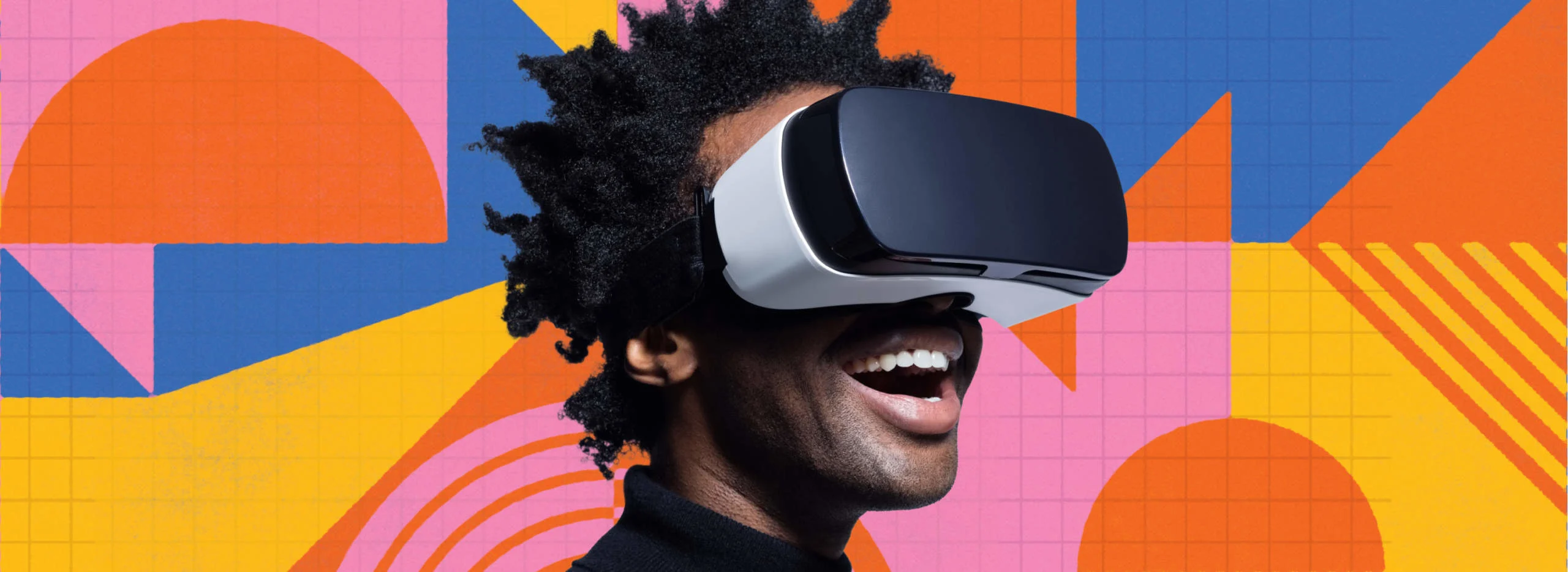

Consumer Behavior Trends: Venturing into the Metaverse
Get The Print Version
Tired of scrolling? Download a PDF version for easier offline reading and sharing with coworkers.
A link to download the PDF will arrive in your inbox shortly.
In 2022, the augmented reality market is forecasted to hit $17 billion in size — and by 2026, this number is projected to jump over $36 billion.
This is no surprise, considering the rise of virtual try-on solutions, social media filters and interactive user manuals. Everywhere you look, ecommerce brands are working to bridge the gap between the physical and digital.
Especially during the global pandemic, augmented reality (AR) and virtual reality (VR) emerged as powerful tools for brands to replicate in-person experiences online. Using these technologies, brands can now give customers the ability to interact with three-dimensionally rendered representations of products in real-time.
But the innovation doesn’t stop there — the next evolution in digital experiences is mixed reality, which combines AR and VR together to create the ultimate immersive experience.
And in no place do we see this trend more ready to break through than in the Metaverse.
Are Consumers Ready to Shop on the Metaverse?
With ecommerce experiencing massive growth and transformation, BigCommerce wanted to understand what factors are influencing the ways consumers shop online. So in our Global Consumer Report, our team surveyed over 4,000 online shoppers in the US, UK, Italy, France and Australia to help uncover the top trends shaping retail today and in the future — including the Metaverse.
According to eMarketer, the Metaverse is “any mixed-reality realm that, while rooted in real life, lets participants collaborate and transact in immersive virtual spaces via augmented reality and virtual reality headsets and controllers.”
Of course, the Metaverse is still early in its development, but that isn’t deterring major brands such as Nike, Gucci, Stella Artois and Samsung from getting in on the action — and even consumers are ready to jump on the Metaverse bandwagon. In fact, Google Trends data shows that global searches for the topic “Metaverse” have spiked since October 2021.

Benefits of Ecommerce in the Metaverse
But what does the Metaverse have to do with ecommerce?
For many traditional retailers, buying and selling in a virtual world may seem a bit far-fetched. But as the Metaverse continues to develop, the virtual-first market shows huge potential for online retailers to transform the way they do business.
Here are a few benefits retailers can expect from selling in the Metaverse:
Personalized customer experiences: While personalization techniques such as product recommendations and chatbots are already common in the ecommerce industry, the Metaverse opens up doors for hyper-personalized experiences such as avatars, branded NFTs and livestream shopping.
New revenue streams: With retail channels already established online and in-store, ecommerce brands can add a third revenue stream through the Metaverse.
Omnichannel commerce: The Metaverse encourages brands to embrace an omnichannel strategy, creating a seamless customer experience across all online and offline channels.
Customer engagement: Just as social media has been a powerful tool in building brand communities, the Metaverse reveals an opportunity for customers to engage with brands and other loyal customers.
With this increase in interest around the Metaverse, BigCommerce wanted to find out whether consumers actually understand the Metaverse, and more importantly, whether they’re ready to shop on the Metaverse.
Consumer Understanding of the Metaverse
Without providing a definition or explanation, we asked consumers what level of knowledge they have about the Metaverse.
Despite the Metaverse still being a new development, 26% of respondents claimed to have a strong understanding of the Metaverse, while 25% reported having a mild understanding. However, our results showed that understanding of the Metaverse and willingness to shop on it scales inversely with age and positively with income.
While knowledge of the Metaverse remained relatively consistent across geographies, Gen Z and Millennials reported a stronger understanding than Gen X and Baby Boomers. This is unsurprising, considering younger generations grew up as digital natives with more exposure to new technology.
Furthermore, our Global Consumer Report revealed that consumers with higher incomes ($100,000 or more per year) tend to have a stronger understanding of the Metaverse, while those with less income (less than $25,000 per year) have little to no understanding.
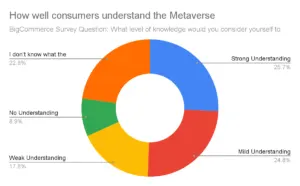
Willingness to Shop on the Metaverse
Of course, just because a consumer understands the Metaverse does not mean that they’re willing to shop on it.
According to PR Newswire, the biggest barriers to metaverse adoption among consumers are 1) “isolation and alienation from friends, family and the real world (37%)”, “followed by privacy concerns (34%) and monetization of personal information (30%).”
So, after providing a definition and showing a video explaining the Metaverse, we surveyed whether consumers are willing to shop on the Metaverse.
The result? A fairly even split between willing (46%) and not willing (52%). Plus, we even discovered a small percentage (2%) already had experience shopping on the Metaverse.

Age and income affects consumers’ willingness to shop on the Metaverse.
Similarly to how age and income affect consumers’ understanding of the Metaverse, these factors also affect shoppers’ willingness to shop on the Metaverse.
Unsurprisingly, Gen Z and Millennials are more inclined to shop on the Metaverse, while older generations are less inclined. Likewise, consumers with higher income are more willing to shop in the Metaverse than consumers with lower income.
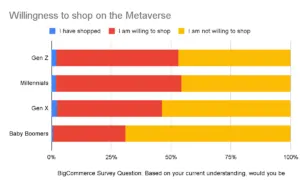
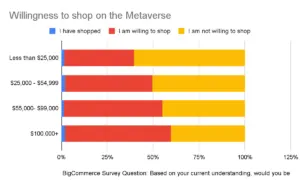
Virtual Goods vs. Physical Goods
For centuries, the traditional commerce model has been physical-to-physical — a customer walks into a brick-and-mortar store, selects a physical product and purchases it in cash. But with the rise of ecommerce, a new transactional model was born: digital-to-physical. Nowadays, a customer can browse an online store, digitally select and purchase a product, and eventually receive a physical product.
But as ecommerce ventures into the Metaverse, even more commerce models are coming into play:
Virtual-to-virtual: With roots in the gaming world, V2V commerce involves the buying and selling of experiences and virtual goods.
Virtual-to-physical: This kind of commerce model involves purchasing a virtual product or experience in a virtual-first marketplace (such as the Metaverse or virtual game) which allows access to a physical product or experience.
Physical-to-virtual: The reverse of V2P, physical-to-virtual commerce involves purchasing a physical product that unlocks a virtual item or experience.
With these new commerce models in mind, we wanted to ask consumers whether they are more interested in purchasing physical or virtual goods — or both — in the Metaverse. According to our Global Consumer Report, the majority of consumers who are willing to shop in the Metaverse are looking to buy both physical and virtual goods (51%), while 35% want to buy physical goods only and 14% want to buy virtual goods only.

Unsurprisingly, our survey also found that Gen Zers and Millennials are most interested in purchasing virtual goods, while older consumers are more inclined to purchase traditional physical goods.
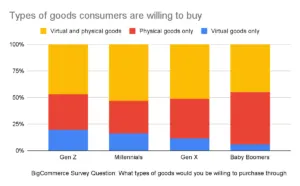
Ecommerce in the Metaverse: Balenciaga.
Although the Metaverse is still in its early stages of development, some ecommerce brands are already getting in on the action, including luxury apparel brand Balenciaga.
As the first luxury brand to partner with Epic Games’ Fortnite, Balenciaga launched a collection of four virtual outfits — aka “skins — and accessories that Fortnite players could purchase in the game. Plus, the brand launched a limited-edition line of Balenciaga x Fortnite clothes that shoppers could buy in-store and online.
By tapping into the gaming world, Balenciaga was able to build buzz not just around its own brand, but also raise awareness for Unreal Engine, Epic Games’ real-time 3D design development software. Blurring the lines between physical and virtual retail, Balenciaga’s campaign is a prime example of how ecommerce brands can leverage the Metaverse to tap into new markets and shopping experiences.
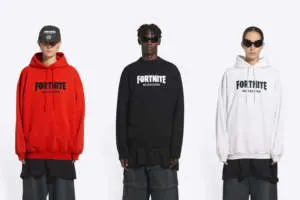
The Final Word
“It’s such an exciting time to be shaping the future of ecommerce,” said Kate Ancketill, CEO and Founder of GDR Creative Intelligence and a keynote speaker at Make It Big 2022. “The Metaverse has great potential to become the new third channel for retail, giving fast-growing online businesses the opportunity to innovate now on how they deliver shopping experiences and drive revenue for what’s to come.”
With the market size expected to hit $678 billion by 2030, it’s no wonder the Metaverse is already a hot topic among both retailers and consumers. As ecommerce continues to evolve and innovate, the Metaverse is poised to transform the future of ecommerce.
For even more insights into the Metaverse and other consumer shopping trends, check out BigCommerce’s Global Consumer Report.
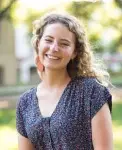
Haylee is a Content Marketing Writer at BigCommerce, where she partners with the SEO team to craft narratives and blog content. She earned a B.A. in English Literature from the University of Texas at Austin and afterward spent a year abroad to pursue a Master's in International Management from Trinity College Dublin. When she’s not writing, you can usually find Haylee with her nose in a book, enjoying live music or scoping out the best local coffee shops.


